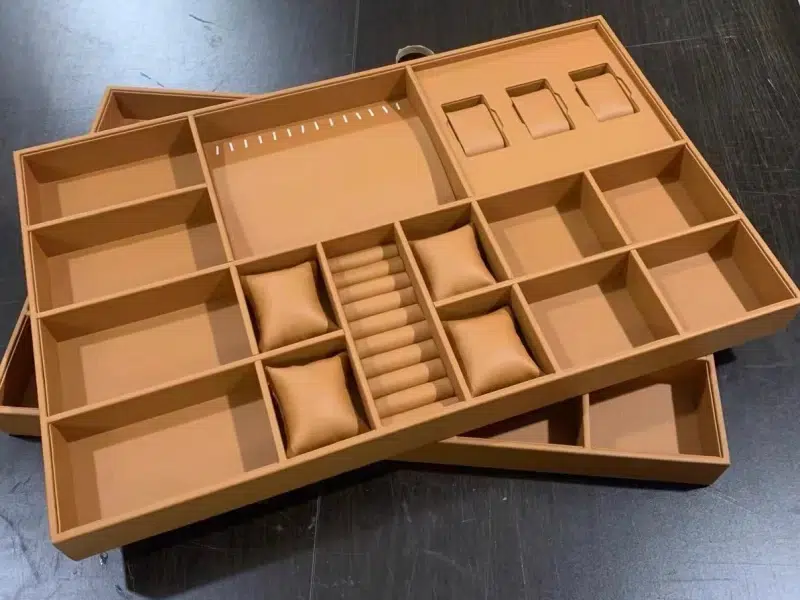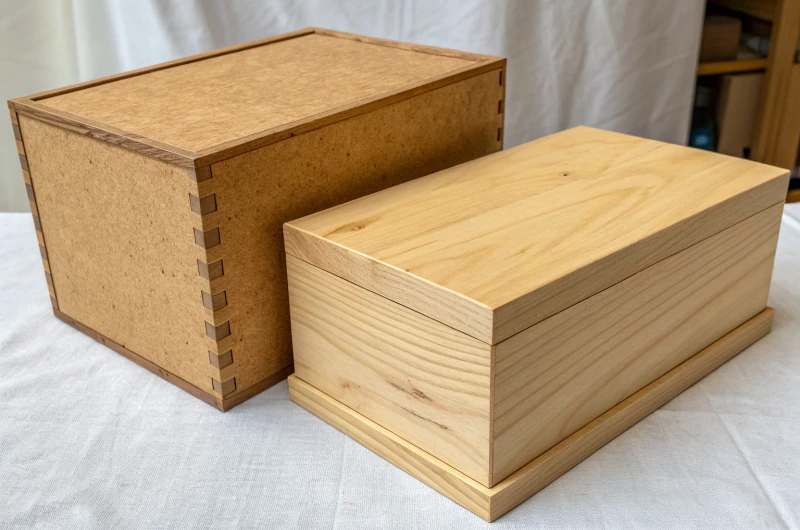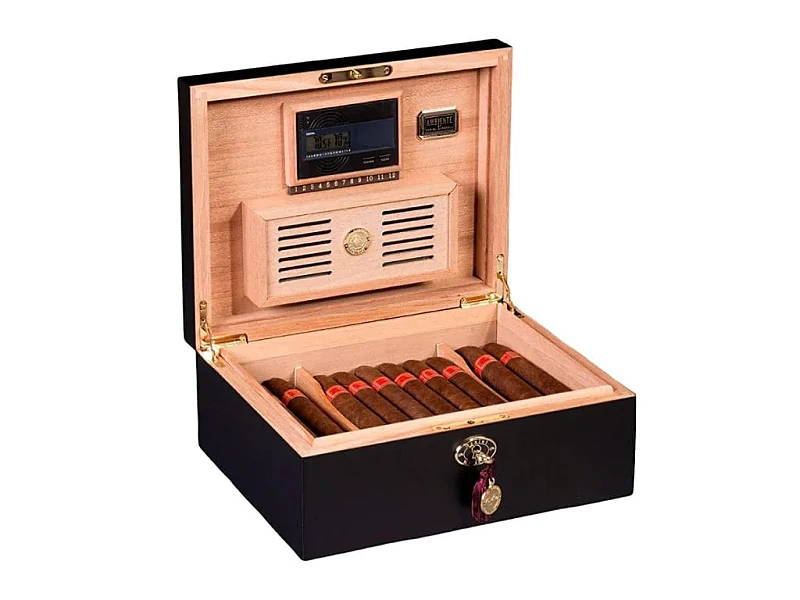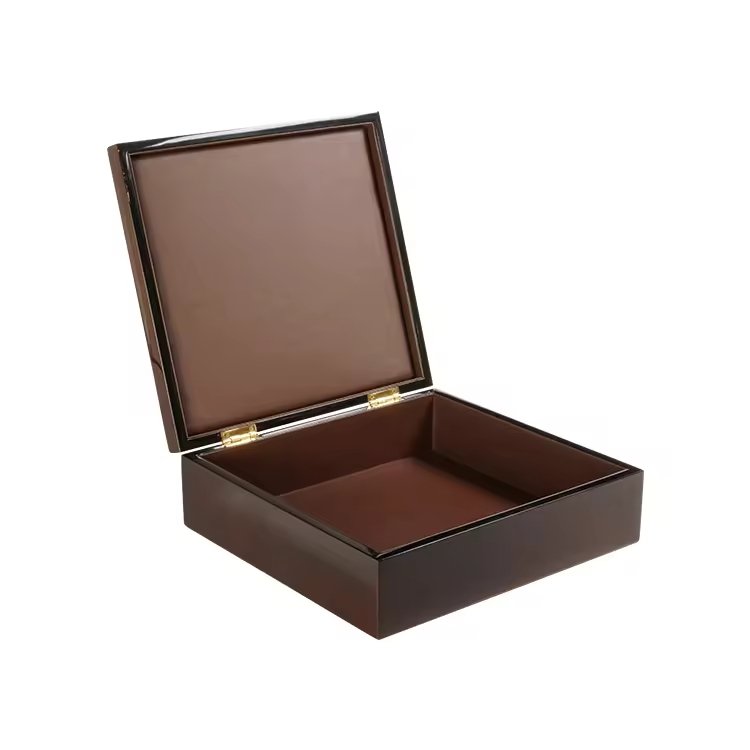
L'intérieur d'une belle boîte à bijoux peut être gâché par une seule couture de cuir PU bullé ou décollé.
C'est pourquoi le choix de l'adhésif n'est pas seulement technique : il définit l'expérience visuelle et tactile.
Au fil des ans, j'ai travaillé sur d'innombrables projets de boîtes à bijoux de luxe, et le principal problème sous-estimé par les clients est la qualité de l'adhésif. Examinons les meilleures pratiques de collage pour des applications de cuir PU durables et sans couture, en particulier sur les surfaces complexes.
Pourquoi le choix de l'adhésif est-il essentiel pour un collage à long terme du cuir PU ?
Le cuir PU est un matériau synthétique à base de plastique qui se comporte différemment du cuir naturel ou du tissu. Il :
- Exigences adhésifs à haute adhérence1 pour une adhérence durable
- Est enclin à bulles superficielles2 si les adhésifs ne sont pas compatibles
- Peut se délaminer au fil du temps avec le mauvaise formule de colle3
- Spectacle de mai des marques ou des décolorations si la colle est trop agressive
| Type de défaillance de l'adhésif | Effets visibles sur la boîte à bijoux |
|---|---|
| Soulèvement ou décollement des bords | Des défauts de fabrication |
| Bulles en surface | Apparence bon marché |
| Saignement ou taches de colle | Gâche l'esthétique de l'intérieur |
| Faible adhérence sur les courbes | Réduit la longévité |
✔ Pour les emballages de luxe, les performances de l'adhésif doivent être à la hauteur de la qualité de l'emballage. la précision de la conception de la boîte elle-même.
Quels sont les types d'adhésifs les plus efficaces pour les surfaces courbes et complexes ?
Tous les adhésifs ne fonctionnent pas bien sur les contours en 3D ou les supports en PU délicats. Voici les types d'adhésifs les plus fiables que j'utilise sur la base de tests réels :
1. Ciment de contact à base de solvant
- Excellente adhérence initiale et tenue à long terme
- Idéal pour courbes et virages serrés4
- Sèche rapidement - à utiliser de préférence avec une application qualifiée
2. Adhésifs PU à base d'eau5
- Plus sûr pour les travailleurs et respectueux de l'environnement
- Le temps de tack plus lent permet un meilleur alignement
- Moins de risques d'endommager le cœur de la mousse ou du panneau de fibres
3. Colle PU thermofusible6 (pour l'automatisation)
- Utilisé dans les intérieurs à revêtement CNC
- Adhésion propre et forte, mais nécessite un support résistant à la chaleur
| Type d'adhésif | Meilleur cas d'utilisation | Point d'attention |
|---|---|---|
| Colle de contact à base de solvant | Angles vifs, joints structurels | Il faut ventiler les fumées |
| Colle PU à base d'eau | Panneaux plats, support respirant | Séchage plus lent - nécessite un temps de pression |
| Colle thermofusible (PU) | Emballage robotisé/automatisé | Peut déformer les PU minces en cas de surchauffe |
✔ I often techniques de mélange-Colle à contact pour les bords détaillés, colle à base d'eau pour les grands panneaux.
Comment éviter les suintements de colle ou les bulles en surface lors de l'application ?
Même le meilleur adhésif peut causer des problèmes si l'application est précipitée ou incohérente.
Meilleures pratiques :
- Utiliser un rouleau ou un pinceau à colle à dents fines pour une répartition uniforme
- Appliquer un couche mince et régulière sur les deux surfaces
- Autoriser temps d'amure avant de presser le PU pour le mettre en forme
- Utilisation moules de presse ou outils à bords courbes pour exercer une pression uniforme
- Évitez de trop étirer le cuir PU, car cela fait sortir la colle de son emplacement.
| Erreur | Problème résultant |
|---|---|
| Sur-encollage | Infiltration le long des coutures |
| Collage immédiat | Provoque des bulles dues à des vapeurs piégées. |
| Pression inégale | Adhésion inégale et ondulations de surface |
Ma règle personnelle : tester chaque nouveau lot de cuir PU avec de la colle sur un petit échantillon-Les matériaux varient subtilement d'un lot à l'autre.
Quels sont les facteurs qui influencent le temps de séchage et la maniabilité de l'enrobage intérieur détaillé ?
Vous avez besoin de temps pour travailler sur les coutures, les coins et les plis, mais vous ne voulez pas attendre indéfiniment. Le temps de séchage est influencé par :
- Humidité et température ambiantes7
- Epaisseur de la couche de colle8
- Matériau du substrat9 (le bois absorbe plus rapidement que le plastique)
- Débit d'air dans l'atelier
| Environnement | Effet sur la maniabilité de l'adhésif |
|---|---|
| Humidité élevée | Ralentissement de l'assèchement, affaiblissement du risque obligataire |
| Climat chaud/sèche | La colle part trop vite |
| Faible ventilation | Séchage irrégulier |
Dans la plupart des cas, nous presser les intérieurs pendant 12 à 24 heures en utilisant des poids légers pour assurer une adhésion uniforme.
Comment garantir une forte adhérence sans endommager les matériaux de revêtement délicats ?
Certains intérieurs en PU sont revêtus de papier fibre, éponge ou microfibrequi peuvent être endommagés par des colles agressives.
Solutions :
- Choisir adhésifs à base d'eau à faible teneur en COV pour les doublures délicates
- Utilisation patchs de test vérifier si le produit est froissé ou taché
- Appliquer un couche d'apprêt barrière sur un support poreux en MDF ou en bois avant le collage
- Éviter toute chaleur excessive pendant le collage, car cela peut déformer la mousse ou soulever le grain.
✔ Toujours faire correspondre la colle viscosité et pH à la souplesse du matériau - les formules dures font rétrécir le PU souple au fil du temps.
Quelles sont les méthodes d'essai qui permettent de confirmer la durabilité et une finition propre et luxueuse ?
Avant de passer à la production complète, je teste toujours 3 à 5 boîtes d'échantillons dans des conditions réelles.
Contrôles de qualité essentiels :
- Test de pelage10: Appliquer une pression, puis retirer après 24 heures
- Exposition à la chaleur11: Simuler 40°C pour imiter les livraisons estivales
- Inspection des bords: Vérifier qu'il n'y a pas de rides, de vergetures ou de saignement de colle.
- Test d'odeur: Les colles à solvant doivent être entièrement éliminées avant la mise en boîte.
- Examen final12: Inspecter sous une lumière oblique pour déceler les ondulations ou le brillant de la colle.
✔ Une boîte peut être magnifique à la lumière du jour - mais l'éclairage violent révèle chaque couture et chaque ride.
Conclusion
L'adhésif adéquat transforme le cuir PU d'un simple revêtement en une expérience luxueuse et durable.
Pour bien faire :
- Faire correspondre les formule adhésive à vos matériaux et à votre méthode d'application
- Contrôlez votre environnement et temps de pression
- Utiliser le bon outils pour les angles, les courbes et la stratification
- Toujours testez votre technique de collage avant d'augmenter la production
Parce que dans les intérieurs de luxe, une finition impeccable commence toujours par ce qu'il y a en dessous.
Nom de marque : WoodoBox
Slogan : Boîtes en bois sur mesure, fabriquées à la perfection
Site web : www.woodobox.com
-
Comprendre les adhésifs à haute adhérence peut vous aider à choisir le bon pour coller efficacement le cuir PU. ↩
-
Apprenez à connaître les bulles de surface afin d'éviter les pièges courants dans vos projets d'adhésifs et d'assurer une finition impeccable. ↩
-
Découvrez les risques liés à l'utilisation d'une mauvaise formule de colle pour éviter la délamination et assurer la durabilité de vos projets. ↩
-
Explorez ce lien pour découvrir les adhésifs les plus efficaces, spécialement conçus pour les courbes serrées et les surfaces complexes, afin d'assurer une liaison solide. ↩
-
Découvrez les avantages des adhésifs PU à base d'eau, notamment leur respect de l'environnement et leur adaptation aux matériaux délicats. ↩
-
Découvrez comment la colle PU thermofusible est utilisée dans les processus automatisés, garantissant des liaisons propres et solides dans la fabrication. ↩
-
Comprendre comment l'humidité et la température affectent le séchage peut vous aider à optimiser votre processus d'emballage pour obtenir de meilleurs résultats. ↩
-
L'étude des effets de l'épaisseur de la colle peut permettre d'améliorer l'adhérence et l'efficacité de vos projets. ↩
-
En vous renseignant sur les différents matériaux de support, vous pourrez choisir les meilleures options pour vos besoins en matière d'emballage. ↩
-
La compréhension du test de pelage peut améliorer votre connaissance des méthodes d'assurance qualité, garantissant ainsi une meilleure durabilité des produits. ↩
-
Les tests d'exposition à la chaleur vous aideront à comprendre comment la température affecte la durabilité de l'emballage, ce qui est crucial pour les livraisons estivales. ↩
-
Un examen de la finition est essentiel pour obtenir un aspect luxueux ; apprenez-en plus pour que vos produits se distinguent. ↩





